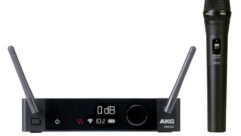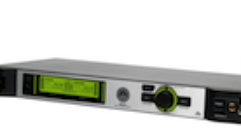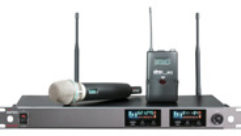
Mipro ACT-82
Sep 1, 2007 12:00 PM,
By John McJunkin
Wireless system with automatic channel targeting combines quality with ease of use.

In March this year, Taiwan-based Mipro introduced its latest offering, the ACT-81 and ACT-82 1-channel and 2-channel digital wireless receivers, respectively. They are intended for use with the ACT-8H handheld transmitter or ACT-8T body-pack transmitter. Because these systems are completely digital, they solve a number of difficulties associated with analog systems. Among various key features touted by Mipro are a color vacuum fluorescent display (VFD) that is readable from virtually any angle and that changes brightness automatically; software-driven PC-monitoring; 10 preset EQ programs, each consisting of 32 parametric filters; 128-bit encryption for security; and both digital and analog outputs. I test-drove an ACT-82 and one each of the handheld and body-pack transmitters.
Starting on the left, the ACT-82 receiver front panel features a power switch, followed by a headphone jack and level control. This clever knob controls levels, but it is also a pushbutton that toggles the headphone output between the receiver’s two channels. LEDs indicate which channel you’re currently hearing.
To the right of the headphone jack and control is the VFD corresponding to the unit’s channel A. This display presents quite a bit of information, including frequency band, group, channel, parameter lock, encryption status, RF strength, signal strength, transmitter battery status (which I really love), squelch metering, EQ preset, ACT indicator, diversity signal indicators, actual working frequency, and address code of that particular receiver for PC control.
I love this display — it features vivid colors against a black background, and it is a huge improvement over black-on-gray LCD displays or even backlit LCDs. The display is easily read in either a dark or light environment. To the right of this first display is channel A’s automatic channel targeting (ACT) button, followed by a rotary encoder knob. The display-ACT button-knob trio is then repeated for channel B. The unit’s rackmount ears feature access points for connection of antennas from the front of the unit.
Starting from the left, the rear panel of the ACT-82 features the channel-B antenna connector, to which an antenna can be directly connected, or a booster may be connected in its place. To its right is an output cluster, consisting of a balanced XLR output, a BNC coaxial AES-3id digital output, and a rotary switch that determines the analog output level. Four increments are available: 0dB, -10dB, -20dB, and -30dB. This particular cluster is associated with the unit’s channel B. To the right of it is a ventilation fan, and then another identical output cluster representing channel A. RJ-11 connectors (out and in) are located to the right of the channel-A output cluster, followed by the unit’s DC power input, which features a safety tab to secure the line to the unit. An IEC AC power input is found next to the right, and then finally the receiver’s channel-A antenna connector.
“ACT” stands for automatic channel targeting, and it represents proprietary technology from Mipro. It facilitates simple frequency synchronization between transmitter and receiver. All I had to do was to press the ACT button on the receiver and point the ACT port on the transmitter toward the button on the receiver within a distance of 1ft. The ACT indicator turned off, and the RF signal indicator illuminated, indicating synchronization of frequencies — pretty simple business. In operation, the unit works in a very straightforward way, which is something I really appreciate. There’s plenty of complexity elsewhere to think about. From the front panel, I was able to switch between antennas or set the system in auto mode, establishing full diversity.
Dialing up one of the system’s 10 EQ presets is also easily accomplished. One minor disappointment here — nine of the 10 presets are not programmable, but they are what they are. The 10th preset is user-programmable, and at the end of the day, that’s all that’s truly necessary, but it would be nice to have access to the parameters of the other nine in order to simplify the use of multiple mics with the system. On the other hand, I was happy to see that it’s not necessary to recall the EQ presets — I was able to dial through the presets and each became active immediately without having to press a button to recall them.
The setup of encryption is very similar to the initial synchronization of frequencies, and having the security of encryption is very welcome. While there is no password-protected locking of the front panel, a lock exists nonetheless — it simply locks out accidental changes. Front-panel control also facilitates changing the identity of the unit for computer monitoring, using Mipro’s DVJ or DVU interfaces (RS-232 and USB, respectively), which facilitates computer monitoring via daisy-chain connection of up to 64 channels at once.
The transmitters feature easily used recharging mechanisms that enable charging of both the transmitter and a backup battery simultaneously — something I really appreciate. Both are capable of up to eight hours of operation on a charge — probably more than enough for most applications. The handheld mic is well made and available in a variety of colors (and even if you have black mics, the rear caps are available in colors to identify mics from front of house). Multiple capsules are available, and the antenna is integrated into the body. The body-pack is also solidly constructed of a magnesium alloy, and features a mini-XLR connector, as expected.
I fired up the whole system and put it through its paces. The first order of business was to test the ACT process, which worked precisely as advertised — and very quickly at that. I was led to conclude by the documentation that it may take a moment to acquire the signal, but it was pretty much instantaneous. I was able to very easily get both mics up and running quickly and with no hassle.
Because the transmission is digital, it’s very clean. There was no discernible noise whatsoever. The cardioid capsule included with the mic sounded great — right in league with any other wireless handheld you’ve ever heard. With the body-pack, the mic choice is up to you, and whatever you choose will be transmitted clearly — again due to the digital transmission, which is constant. The signal-to-noise ratio in an analog system, on the other hand, deteriorates if the signal weakens. In the case of digital, it’s all or nothing, as long as you’re within the system’s transmission range. The digital signal is also far less susceptible to interference.
I was absolutely thrilled with the quality of the signal in the Mipro ACT-82 system. Not only is the signal successfully delivered via the digital system, but the handheld mic also sounds great itself. It’s easy to install and use, and it’s well made — all components feel solid and robust. This system delivers a high value, and I would recommend it in the strongest terms if you’re in the market for a wireless system.
PRODUCT SUMMARY
Company: Mipro
www.mipro.tw
Product: ACT-82 system
Pros: Well-constructed, high-quality digital system.
Cons: Lack of user access to all EQ presets.
Applications: Live-sound wireless-microphone applications.
Price: $6,000 (ACT-82 with ACT-8H handheld transmitter and ACT-8T body-pack transmitter)
SPECIFICATIONS
Overall system:
Frequency range: UHF 614MHz-870MHz
Switching bandwidth: 24MHz
Digital resolution: 24-bit/44.1kHz
Latency: 4ms
Audio frequency range: 20Hz-20kHz (±2dB)
Audio dynamic range: 110dB (A-weighted)
THD: 0.03% at 1kHz
Receiver:
Sensitivity: 12dBµV @ S/N 106dB (A-weighted)
Bandwidth: 24MHz
Channel grid: 25kHz
Image and spurious rejection: 95dB
Antenna input: 50 dual-TNC female connector
Power input: 90VAC-264VAC/11VDC-13VDC
Weight: 6lbs. (2.7kg)
John McJunkinis the principal of Avalon Podcasting in Chandler, Ariz. He has consulted in the development of studios and installations, and he provides high-quality podcast production services.









